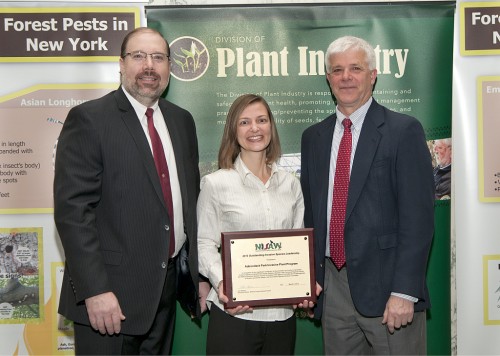Public-Private Partnerships Key to Program’s Effectiveness
The Adirondack Park Invasive Plant Program (APIPP) received the 2013 National Invasive Species Awareness Week Award in the category of Outstanding Achievement in Invasive Species Leadership, program partners announced today. APIPP is a partnership program founded by The Nature Conservancy’s Adirondack Chapter, New York State Departments of Environmental Conservation (DEC) and Transportation (DOT) and New York State Adirondack Park Agency (APA). This national recognition is for APIPP’s leadership in invasive species prevention and control, including collaboration and coalition building. DEC Commissioner Joe Martens presented the award to APIPP Director Hilary Smith during a Forestry Awareness Day celebration at the Legislative Office Building in Albany today.
The first program of its kind in New York State, APIPP started in 1998 as a grassroots effort to implement a landscape-level approach to address threats posed by invasive species and minimize costs to governments, businesses and landowners. It has since harnessed the energies of hundreds of volunteers, forged countless partnerships and influenced local and statewide action against invasive species. APIPP served as the model for seven other programs, known as Partnerships for Regional Invasive Species Management (PRISM), now supported in large part through the state’s environmental protection fund. The program has also shared best practices at Weeds Across Borders conferences in Mexico and Canada.

From left to right: Kevin King, NYS Department of Agriculture and Markets director of Plant Industry; Hilary Smith, APIPP director and NYS Department of Environmental Conservation Commissioner Joe Martens.
“All New Yorkers hold a stake in protecting our natural resources for future generations, which is why it is so critical to address invasive species. APIPP has been leading the charge for more than a decade. This is well-deserved recognition of the excellent work APIPP has done and a testimony to what can be accomplished through private-public partnerships, dedicated funding through New York’s Environmental Protection Fund, and coordination at the state level,” said DEC Commissioner Joe Martens.
“The Adirondack Park—known for its forest and fresh water resources—is one of the few places where opportunities still exist to prevent invasive species from becoming widespread. We are proud of this partnership and the results it continues to produce for people and nature,” said Michael Carr, Executive Director of The Nature Conservancy’s Adirondack Chapter.
New York State Department of Transportation (NYSDOT) Commissioner Joan McDonald said, “Thanks to Governor Andrew Cuomo’s leadership, the State Department of Transportation is continuing to work with our State and local environmental protection partners to control the spread of invasive plants along transportation corridors in the Adirondack Park. We’re very pleased that the Adirondack Park Invasive Plant Program has received this prestigious award and we look forward to future efforts to protect native plant species in the Park, helping to preserve its rich heritage and natural beauty.”
APA Chairwoman Leilani Ulrich stated, “The Adirondack Park Invasive Plant Program is an excellent example of how stakeholders with diverse responsibilities and interests can align on an issue of common ground to accomplish great things. Year after year our partnership strengthens as a result of dedicated staff and volunteers who are fully committed to preventing the negative economic and environmental impacts of invasive species. APIPP is a most worthy recipient of this award.”
APIPP Director Hilary Smith said, “We are deeply honored by this recognition, which affirms the importance of local action and strong partnerships. With the extraordinary dedication of so many partners, collaborators, landowners and volunteers working together, we are making a difference to address tough challenges and know that solutions are within our grasp.”
Examples of APIPP’s work that earned the group the Outstanding Invasive Species Leadership Award include the following:
- Instituting early detection programs with hundreds of volunteers surveying lands and waters and gathering important baseline data to help identify priority areas for prevention and management.
- Directly reaching more than 1,000 citizens per year through education programs, such as free training in forest pest detection, aquatic invasive species identification and invasive plant management techniques.
- Reaching thousands of people through a seasonal news column, Eye on Invasives, published in the Adirondack Daily Enterprise and Adirondack Express.
- Leveraging private funds to deploy professional rapid response teams to eradicate new infestations encroaching ecologically significant areas.
- Helping to support boat launch stewardship programs that reach more than 30,000 recreationists per year.
Last year, Governor Andrew M. Cuomo signed the Invasive Species Prevention Act which creates a statewide regulatory system to prohibit or limit the sale and transport of known invasive plants and animals that threaten communities, natural areas and job-creating industries that depend on natural resources. The Governor has also asked DEC to take immediate action by completing a comprehensive, environmental review to determine how we can combat invasive species in Lake George.
The selection committee for this year’s award included representatives from the Aquatic Nuisance Species Task Force (an intergovernmental organization) and its regional panels, the National Invasive Species Council, the Invasive Species Advisory Committee, and the Federal Interagency Committee for the Management of Noxious and Exotic Weeds.
Invasive species are a top threat to our lands and waters. Invasive animals and plants drive out native species and upset the food chain, ruin crops, degrade forests and fisheries, negatively impact recreation and can harm humans. They typically come from other parts of the world and, in the absence of natural checks and balances, rapidly reproduce and spread. Japanese knotweed, spiny water flea and Eurasian water milfoil are among the most threatening in the Adirondacks of upstate New York. Emerald ash borer, Asian longhorn beetle and hydrilla are nearby. Researchers estimate invasive species cause environmental losses and damages of nearly $120 billion a year nationwide.







No Comments so far ↓
There are no comments yet...